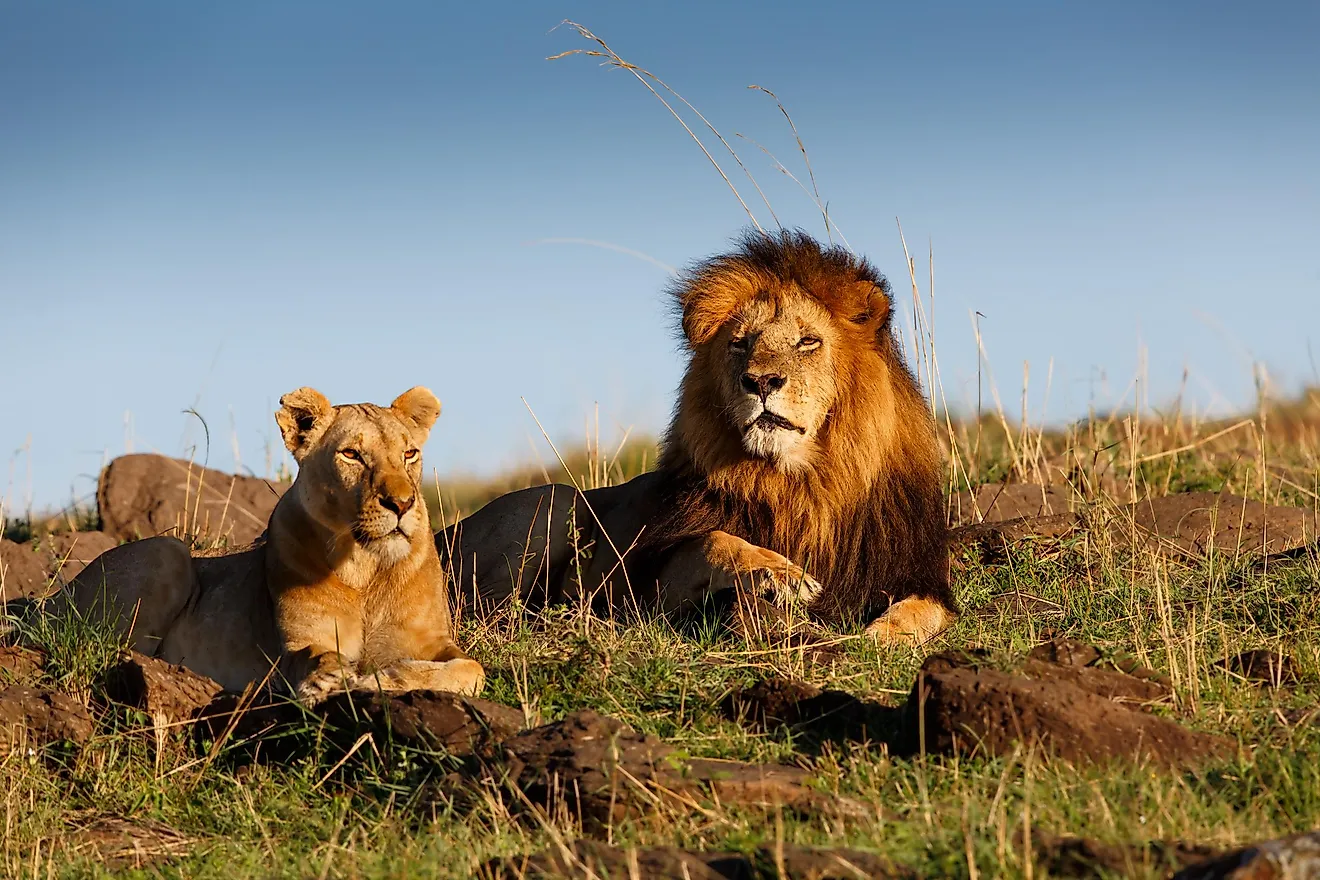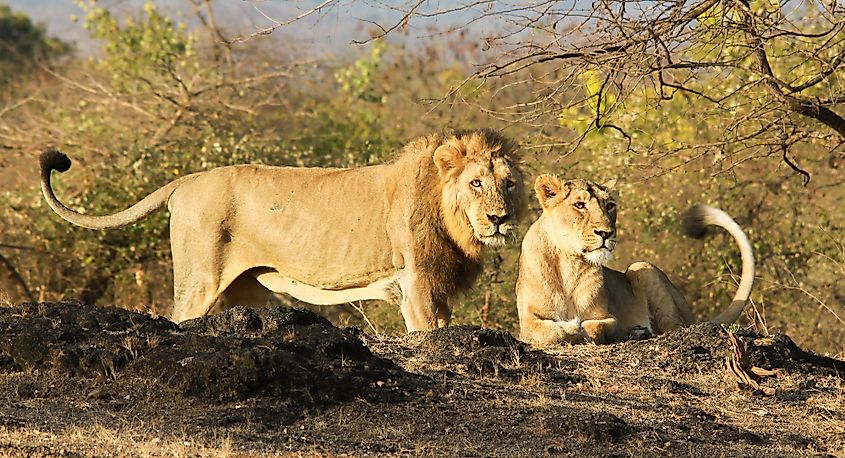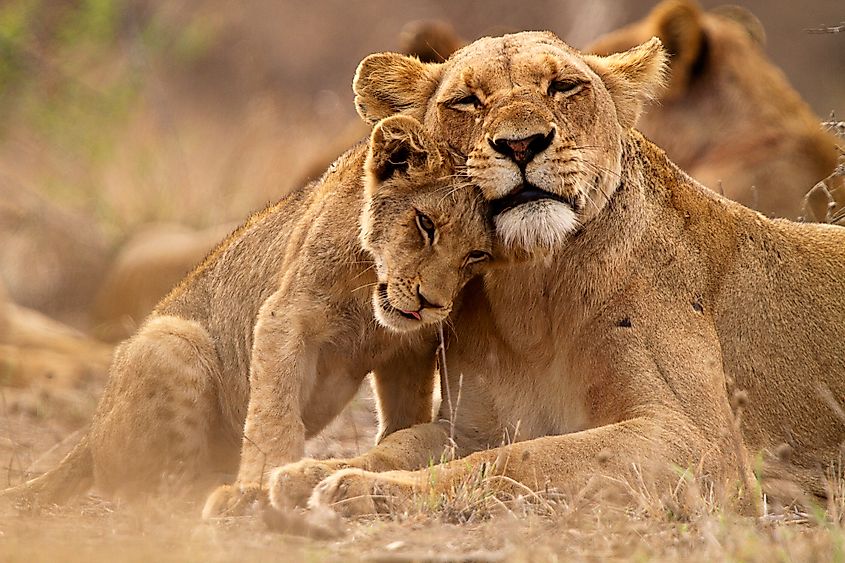What Are The Differences Between Asiatic Lions And African Lions?

The Asiatic lion is a rare lion native to India and restricted to the Gir National Park. The lion was first described in 1826 by Johann Meyer, an Austrian zoologist, and has been listed as endangered ever since. With around 500 individuals left, the Asiatic lion is believed to have diverged from the African counterparts 186,000 years ago and moved towards India, where it evolved in isolation after the gene flow was disrupted by the extinction of lions in the Middle East and Europe. The lion is closely related to West African and North African lions more than they are to Southern and East African lions. The African lion, on the other hand, is spread out across Africa, with the most numbers concentrated around the East African region. The African lion was first described in 1758 by Carl Linnaeus in his book Systema Naturae. The North and West African lions diverged from the East and Southern African lions about 180,000 years ago when the equatorial forest expanded and cut off the two regions. These two lions are the dominant subspecies left on the planet, and they exhibit several differences that set them apart from each other. The differences include the following.

Image: Asiatic lion and lioness.
Size
African lions are larger than their Asiatic counterparts. A male African lion weighs between 330pound and 500 pounds, with females averaging about 345 pounds. The largest African lion ever recorded weighed 800 pounds and measured 11 feet from nose to tail. Male Asiatic lions weigh between 350 and 450 pounds, with females weighing between 240 and 360 pounds. The shoulder height in Asiatic males stands between 3.51 and 3.94 feet, while females stand between 2.62 and 3.51 feet. The largest Asiatic lion ever recorded reached 9.7 feet long from the tip to the tail to the nose.
Mane
The male Asiatic lions have sparse and exceptionally short mane with its ears visible. Another stand out mane feature is the color. The short mane is dark and less developed. Male African lions have a more prominent, fuller mane that covers the whole head and falls back over the shoulders. The mane signals how healthy a male is to females, which they use to attract them and to intimidate other rivals.
Elbow And Tail Tufts
Asiatic lions have more pronounced tufts of hair on their elbows and tails compared to their African counterparts. The tail tuft covers the whole back area of the tuff, and its function is yet to be determined. African lions have minimal tufts of hair on their tails and elbows.
Skin Folds
Asiatic lions have a long-running longitudinal fold of skin under their bellies. The skin fold is one of the most distinguishing features that are unique to Asiatic lions. African lions do not have this fold.
Skulls
Asiatic lion skulls have a feature known as bifurcated infraorbital foramina that refers to small holes in the skull, allowing blood vessels and nerves to pass to the eye. Any lion skull that has these two holes belongs to an Asiatic lion. African lions, on the other hand, have one infraorbital foramen, and this, however, does not imply that their eyesight is inferior to that of Asiatic lions. It is only a physical feature that they do not possess. The African lion skull is also more prominent than the Asiatic lion skull.
Size Of The Pride
Asiatic lion prides tend to be smaller, and the biggest one ever recorded had five adult females with most surviving with just two females. The reason behind this is that Asiatic lions prey on smaller animals, which makes sense to have a smaller attacking force. Another possible reason is the size of their habitat. Gir National Park is not that big, and the hunting space is too constricted for the lions to operate in large pride. African lions operate in large prides of up to six females and two males with cubs. Faster and agile females do the hunting while the males guard their territories and fight off threats.

Image: Lioness and cub at Kruger National Park, South Africa
Sociability Of Male Lions
Every African lion pride has a male or two whose role is to defend the pride from other male lions. If outsider males take over the pride, they usually kill all the cubs belonging to the previous males before taking over control. Male Asiatic lions move independently in groups of two, and they only associate with females during mating season or when coordinating more gigantic kills. Moving independently allows the lions to control more territory without anything holding them back.
Size Of Prey
Asiatic lions prey on smaller animals due to their location. Chital deer is the most common prey in the Gir forest, and it weighs only about 110 pounds. The water buffaloes in India are smaller than the ones Africa and Asiatic lions tend to avoid them most times. The African lion preys on larger animals like wildebeests, and zebras which weigh between 600 and 800 pounds. Buffalos, which weigh between 1000 and 2000 pounds, are the African lion’s favorite prey that can only be brought down by a highly coordinated hunt.
Interesting Facts About Lions
Despite being called the King of the Jungle, lions never live in the jungle, and they prefer open grasslands, shrubs, deserts, woodlands, and scrub complexes where they can see and stalk their prey from a distance. Female lions stay with pride forever until they die. While male lions leave the pride to start their own once they grow up. Female cubs grow up as part of the pride and eventually take over from the older females once they die. Lions once roamed the whole globe from North America to Europe to the Middle East and Asia. Currently, they are only found in Africa and the Gir forest in India. Male lions have the loudest roar of all the cat species that can be heard 5 miles away. They use roars to find mates, warn other male lions, or find their pride. Despite their reputation, lions are the second largest cats on the planet, and tigers hold the title of the biggest cats existing right now. Many countries use the lion as the national symbol, and some of them include England, Belgium, Albania, Bulgaria, Netherlands, Ethiopia, Luxembourg, and Singapore. Lions sleep for up to 20hours in a day, and when they walk, their heels never touch the ground. A lion can run for up to 50 mph and jump as much as 36 feet into the air.
Threats To Lions
Big cats around the world are in sharp decline due to forces beyond their control. Loss of habitat has hit lions hard as this has led to a reduction of prey numbers starving them off their food source. Conflicts with humans and livestock have also led to many lions losing their lives over the years. As human populations increase and encroach on what was once lion territories, the lions have been forced to start attacking livestock. In retaliation, they have been hunted down and killed. Diseases and climate change have also affected lion populations. Africa is getting drier and hotter, and this is drying up water sources and grass, driving away zebras, antelopes, and buffaloes, which is the source of food for lions. Inbreeding depression has also caused the gene pool to weaken considerably, and this has made lions vulnerable.











